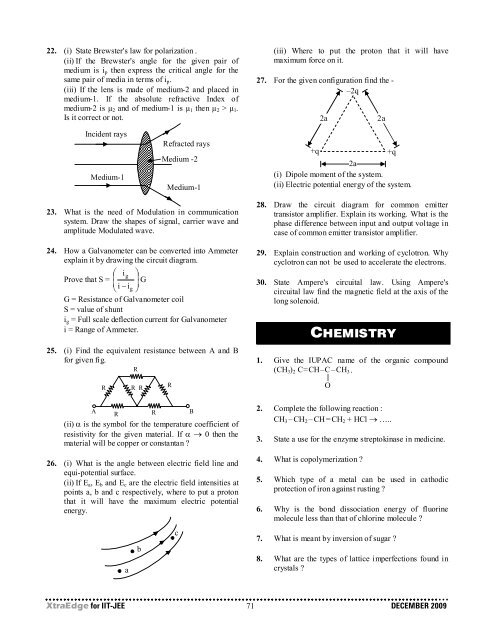Create successful ePaper yourself
Turn your PDF publications into a flip-book with our unique Google optimized e-Paper software.
22. (i) State Brewster's law for polarization .<br />
(ii) If the Brewster's angle for the given pair of<br />
medium is i p then express the critical angle for the<br />
same pair of media in terms of i p .<br />
(iii) If the lens is made of medium-2 and placed in<br />
medium-1. If the absolute refractive Index of<br />
medium-2 is µ 2 and of medium-1 is µ 1 then µ 2 > µ 1 .<br />
Is it correct or not.<br />
(iii) Where to put the proton that it will have<br />
maximum force on it.<br />
27. For the given configuration find the -<br />
–2q<br />
2a<br />
2a<br />
Incident rays<br />
Medium-1<br />
Refracted rays<br />
Medium -2<br />
Medium-1<br />
+q<br />
+q<br />
2a<br />
(i) Dipole moment of the system.<br />
(ii) Electric potential energy of the system.<br />
23. What is the need of Modulation in communication<br />
system. Draw the shapes of signal, carrier wave and<br />
amplitude Modulated wave.<br />
24. How a Galvanometer can be converted into Ammeter<br />
explain it by drawing the circuit diagram.<br />
⎛ i ⎞<br />
Prove that S = ⎜<br />
g<br />
⎟ G<br />
⎝ i − i g ⎠<br />
G = Resistance of Galvanometer coil<br />
S = value of shunt<br />
i g = Full scale deflection current for Galvanometer<br />
i = Range of Ammeter.<br />
25. (i) Find the equivalent resistance between A and B<br />
for given fig.<br />
R<br />
A<br />
R<br />
R R<br />
R<br />
R R B<br />
(ii) α is the symbol for the temperature coefficient of<br />
resistivity for the given material. If α → 0 then the<br />
material will be copper or constantan ?<br />
26. (i) What is the angle between electric field line and<br />
equi-potential surface.<br />
(ii) If E a , E b and E c are the electric field intensities at<br />
points a, b and c respectively, where to put a proton<br />
that it will have the maximum electric potential<br />
energy.<br />
a<br />
b<br />
c<br />
28. Draw the circuit diagram for common emitter<br />
transistor amplifier. Explain its working. What is the<br />
phase difference between input and output voltage in<br />
case of common emitter transistor amplifier.<br />
29. Explain construction and working of cyclotron. Why<br />
cyclotron can not be used to accelerate the electrons.<br />
30. State Ampere's circuital law. Using Ampere's<br />
circuital law find the magnetic field at the axis of the<br />
long solenoid.<br />
CHEMISTRY<br />
1. Give the IUPAC name of the organic compound<br />
(CH 3 ) 2 C = CH – C – CH 3 .<br />
||<br />
O<br />
2. Complete the following reaction :<br />
CH 3 – CH 2 – CH = CH 2 + HCl → …..<br />
3. State a use for the enzyme streptokinase in medicine.<br />
4. What is copolymerization ?<br />
5. Which type of a metal can be used in cathodic<br />
protection of iron against rusting ?<br />
6. Why is the bond dissociation energy of fluorine<br />
molecule less than that of chlorine molecule ?<br />
7. What is meant by inversion of sugar ?<br />
8. What are the types of lattice imperfections found in<br />
crystals ?<br />
XtraEdge for <strong>IIT</strong>-<strong>JEE</strong> 71 DECEMBER 2009

















